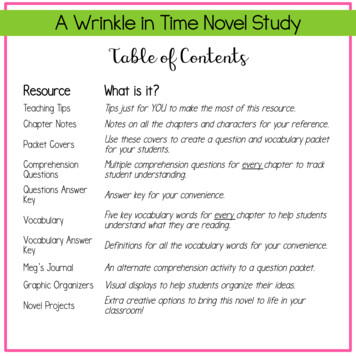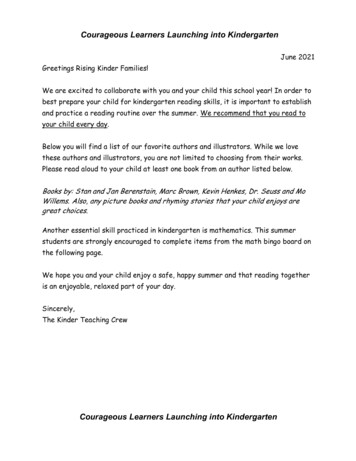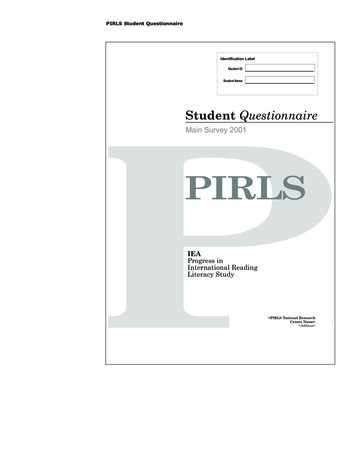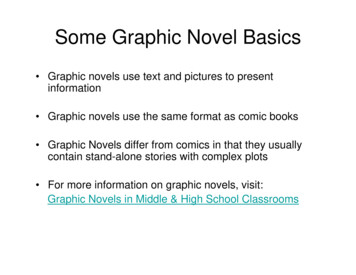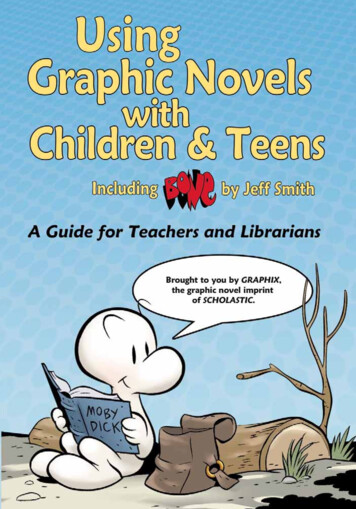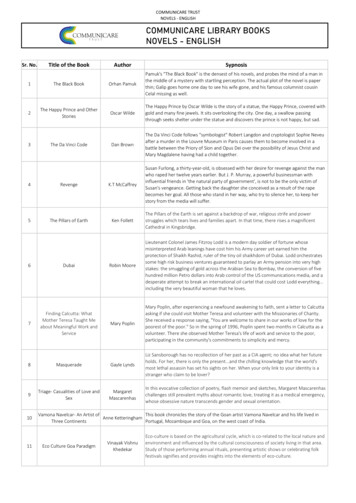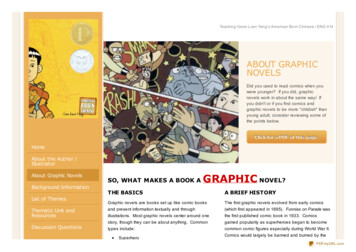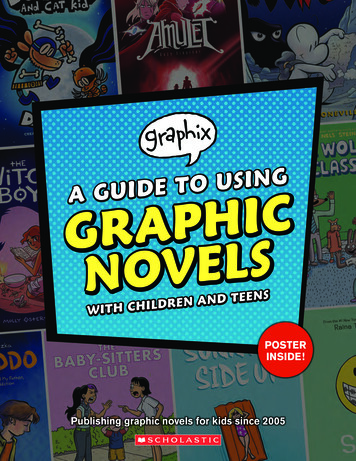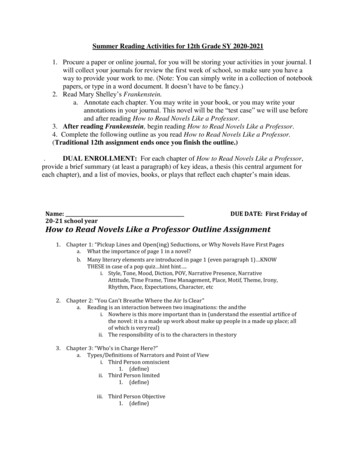
Transcription
Summer Reading Activities for 12th Grade SY 2020-20211. Procure a paper or online journal, for you will be storing your activities in your journal. Iwill collect your journals for review the first week of school, so make sure you have away to provide your work to me. (Note: You can simply write in a collection of notebookpapers, or type in a word document. It doesn’t have to be fancy.)2. Read Mary Shelley’s Frankenstein.a. Annotate each chapter. You may write in your book, or you may write yourannotations in your journal. This novel will be the “test case” we will use beforeand after reading How to Read Novels Like a Professor.3. After reading Frankenstein, begin reading How to Read Novels Like a Professor.4. Complete the following outline as you read How to Read Novels Like a Professor.(Traditional 12th assignment ends once you finish the outline.).DUAL ENROLLMENT: For each chapter of How to Read Novels Like a Professor,provide a brief summary (at least a paragraph) of key ideas, a thesis (his central argument foreach chapter), and a list of movies, books, or plays that reflect each chapter’s main ideas.Name:20-21 school yearDUE DATE: First Friday ofHow to Read Novels Like a Professor Outline Assignment1. Chapter 1: “Pickup Lines and Open(ing) Seductions, or Why Novels Have First Pagesa. What the importance of page 1 in a novel?b. Many literary elements are introduced in page 1 (even paragraph 1) KNOWTHESE in case of a pop quiz hint hint .i. Style, Tone, Mood, Diction, POV, Narrative Presence, NarrativeAttitude, Time Frame, Time Management, Place, Motif, Theme, Irony,Rhythm, Pace, Expectations, Character, etc2. Chapter 2: “You Can’t Breathe Where the Air Is Clear”a. Reading is an interaction between two imaginations: the and thei. Nowhere is this more important than in (understand the essential artifice ofthe novel: it is a made up work about make up people in a made up place; allof which is very real)ii. The responsibility of is to the characters in the story3. Chapter 3: “Who’s in Charge Here?”a. Types/Definitions of Narrators and Point of Viewi. Third Person omniscient1. (define)ii. Third Person limited1. (define)iii. Third Person Objective1. (define)
iv. Stream of consciousness1. (define)v. Second Personvi. First Person Central1. (define)vii. First person secondary1. (define)b. Why is it important to trust your narrator?4.Chapter 4: “Never Trust a Narrator with a Speaking Part”a. Problems with first person narratorsi. Stop believing narrator when you see “I”ii. Often times character-narrators simply don’t know what’s going on or can’t fullyprocess what theysee.iii. First person narration is the perfect vehicle for offering something less than the whole truth andnothing but the truth5.Chapter 5: “A Still, Small Voice (or a Great, Galumphing One)”a. How writers use voice and why matters to you, the readeri. If point of view is about which cat is telling the story and whether he’s looking at the world from ontop of the rock or under it, then is about what sort of cat he is. It’s about WORDAnd WORD .ii. Differentiation is required for multiple voices in a novel (you must keep them sorted out!)iii. How do you characterize the speaker? (and different speakers?)iv.is meaning; what a narrator says and how he says it changes the story being told.6.Chapter 6: “Men (and Women) Made out of Words, or My Pip Ain’t Like Your Pip”a. The reader plays a big part in creating the charactersb. We create our own versions of characters based on our own experiences and history and knowledgec. What makes us so invested in a character? “Caution: what follows is made up and only ever happened in themind of the writer and, should you continue, in your mind as well.”d. Internal Consistency is one of the main things an audience demands of a literary worke. Authors don’t fully develop characters purposefullyi. Only tell you as much as you absolutely need to know why?ii. Iceberg Theory: keep characters mostly under the surface7.Chapter 7: “When Very Bad People Happen to Good Novels”a. Evil Characters!b. Distance from reader to novel that makes the evil things in a novel bearablei. “anti-heroes” (define)8.Chapter 8: “Wrinkles in Time, or Chapters Just Might Matter”a. What are the purposes of chapters in a novel?b.Chapters can be whatever the novelist wants them to be; help teach us how to read the particular novel
c.d.e.9.i. Beginning-middle-endii. Mini-narrativesiii. Plot twistsiv. punchy finishesJust think: Can the chapters be freestanding stories that make sense out of the context of their novel?Just think: Do they focus on single events or chains of occurrences?Just think: Do the mini-endings allow for upticks in tension, suspense, or revelation?Chapter 9: “Everywhere is Just One Place”a. “ ” doesn’t exist in a novel; but themes are everywhereb. The reader matters; they are at the heart of every novelc. How is the novel about ordinary life; middle-class, working-class, or down and out?i. Why is this important?10. Chapter 10: “Clarissa’s Flowers”a. Characters are revealed by their actions and words; the items that surround them, tooi. Character1. Can form a sort of motif in their repetition2. Typically reveal aspects of his personality as well as key ingredients of the story: plot,significance, idea, motif, themeii. Readers are the ultimate arbiters of meaning in a work; (writers can suggest meaning andsignificance, but ultimately, readers make the final call)211. Chapter 11: “Met-him-pike-hoses”a. We know authors by their wordsb. Word choice and placement define a writer’s style, tone, diction, etc.c. Add readers, add meaningd.12. Chapter 12: “Life Sentences”a. No length requirement for sentences exceptb. Make connections between style and story13. Chapter 13: “Drowning in the Stream of Consciousness”a. All representations of consciousness are andb. S of C aims to get inside characters’ mindsi. Thoughts will go where they will, leap in ways that defy logic, and take on a life of their own; wholejumble of thought, instinct, pre-thought, reflex and response to stimulus which the character issubjectii. Humans experience time subjectivelyc. It is impossible to see into another mind, so writers therefore employ devices that create the illusionof consciousness14. Chapter 14: “ The Light on Daisy’s Dock”a. To understand characters, you have to know their the desire usually finds an emblem to give it tangibleexpressionb. What are the characters’ ultimate goals? Not always easy to spot!15. Chapter 15: “Fiction About Fiction”a. What is “metafiction”?b.c.d.Self-referential writingi. Some writers choose not to emphasize the “made-ness” of the book; this emphasis is called“ ”; literary realists tend to do this to the story and relegate the messy business of artisticself-awareness to the backgroundAll novelists/novels are influenced by other novels (whether they know it or not)Fiction cuts itself loose from the moorings of reality so that it can give pleasure, so that the imagination canrun free of any constraints but its own.16. Chapter 16: “Source Codes and Recycle Bins”a. Novel is both counterfeit and authentic
b.c.d.e.Novels come from authors’ personal experiences, history, media (current events), and other books they havereadWriting and reading grow out of experienceOne of the most important things is a writer’s ability to see what’s flawed in society. And what’s funny.The Law of Novel Paradox: Novels grow out of , which writers then must make and to readers.17. Chapter 17: “Improbabilities: Foundlings and Magi, Colonels and Boy Wizards”a. Novels let us become people we aren’t; we become the charactersb. Novel is about US. Come at a time of the rise of the middle classc. We become the characters in the novels.i. Novels want an emotional investment of their readers.ii. Goal: make us love (or hate) the charactersiii. Characters: persons we can react to, relate to, accept or reject, identify with, suffer overiv. Readers choose the degree to which they identify with characters18. Chapter 18: “What’s the Big Idea—or Even the Small One?”a. Doesn’t matter how good the is if the is lousyb. For many, novel is as close as we will ever come to philosophyc. Novel is the perfect medium for capturing individual existence, and in turn for capturing the experience of thegroup (What does it mean to be human? How can we conduct our lives to best effect? )3
19. Chapter 19: “Who Broke My Novel?”a. Best way to organize a novel is the way that makes the most sense for THAT bookb. Novel newc. Novels are told differently; many no longer follow a linear storyline20. Chapter 20: “Untidy Endings”a. The degree of closure in the ending of the novel is in direct proportion to the eagernessof the novelist to please his audienceb. Openings tell us where we’re going, endings tell us where we went!c. Even novels about real people are inventionsd. Popular genres stick to the endings; novels usually end in two ways, though: leaving theprotagonist hanging, or ending with unfinished business421. Chapter 21: “History in the Novel/The Novel in History”a. Every novel is a wrestling match between the h and forces of its own time (sometimes thehistory is apparent, sometimes it’s not, but it’s always present)b. The thing about history and the novel is that readers have to put in the themselves22. Chapter 22: “Conspiracy Theory”a. Novels ASK to be read, and tell us how to read themb. Meaning in fiction is the result of a conspiracy between two and twoc. Without an audience, novels have no meaningd. All novels are ambiguouse. Law for All Reading: the novels you readf. Novel should be INTERACTIVE in the fullest sense.I am excited to be working with all of you this coming semester. As you are progressing throughyour summer reading assignments, if you have any questions, email me atangie marks@piedmontacademy.com. Your summer reading activity will count as your firstmajor grade in 12th grade English. For DE students: This class will be treated as a collegeclass, so I will not provide many major grades in this course; therefore, it is imperative to startoff strongly at the beginning of the term.
2. Read Mary Shelley's Frankenstein. a. Annotate each chapter. You may write in your book, or you may write your annotations in your journal. This novel will be the "test case" we will use before and after reading How to Read Novels Like a Professor. 3. After reading Frankenstein, begin reading How to Read Novels Like a Professor. 4.

